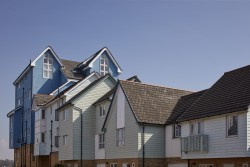As offsite construction's popularity grows, David de Sousa, Director at AHR, provides a simple overview on the growing popularity of modular architecture and how it can deliver across a range of sectors.
It's undeniable that modular and offsite construction is one of the construction industry's most talked about topics. As the housing crisis deepens and public services look to find more efficient ways to modernise their estates, the government and developers are tasked with finding a solution. It is this demand that has presented the opportunity to utilise offsite construction such as volumetric modular and as they have the potential to provide flexible solutions at high volume and quick turnaround when implemented correctly.
However, public perception is key to maintaining support for the continued development of these projects. This places architects in a unique position at the forefront of designing high quality and cost-effective modular projects - while also dispelling the myths that surround the concept, by integrating new technology and positioning it as a viable and innovative solution - whether that's in residential developments or the health and education sectors.
There are a range of legacy issues that modular faces as take up increases, most damaging of which is likely the impact that post-war prefabricated housing had on public perception. The priority for architects going forward must be to ensure that design never takes a back seat, and to take advantage of the potential design benefits modular presents. It's crucial that people see that modular building does not have to result in bland and stale design work.
Another issue that hit the headlines in recent months, is the Environmental Audit Committee's concerns that modular construction can create dwellings prone to overheating. This is a legitimate concern when not tackled effectively, however by introducing heat recovery systems and effective ventilation, the design and construction sector can ensure that this is overcome.
In fact, modular has the potential to improve energy efficiency through the creation of air-tight dwellings - improving the likelihood that projects meet Passive Haus standards. With all that taken into consideration, it is little wonder modular construction has attracted so much attention.
Modular building requires a radically changed design and build compared to traditional methods of construction. The most notable difference between the two being the liaison between manufacturers and architects and the uniquely complex supply chain that this creates.
For architects, building a strong relationship with manufacturers and maintaining a constant line of communication throughout the design, fabrication and transport process is key. Aligning both the architect and manufacturer's approach through the intelligent application of technology, facilitates a manufacturing process that maximises efficiencies, allowing both sides of the process to push the boundaries of design, which in turn creates more desirable and affordable homes. Efficiently planned and manufactured developments are the key route to successfully solving the affordable housing shortage, as well as providing cost-effective public redevelopment options.
The architect's role in this process goes beyond simply designing the building itself. It extends to the effective use of building information modelling (BIM), and aligning this with the fabrication processes. The RIBA Design for Manufacture and Assembly (DfMA) guidelines seek to align this methodology with the RIBA Plan of Works Stages to illustrate how this process can help to streamline and increase the productivity of building homes throughout the manufacturing process. By adopting a streamlined offsite manufacturing process, better quality projects can be manufactured more rapidly at reduced cost, which also helps to tackle issues around the current skills crisis in the construction industry.
Building via modular effectively can provide benefits that have the potential to totally transform the way in which we look at residential developments, allowing the industry to work smarter to achieve lofty housing targets. This is in addition to the potential that modular presents for the education and healthcare sectors, the repeatability, energy efficiency and quick delivery that modular units provide, offers the ideal solution in replenishing ageing NHS estates and schools.
The implementation of plug-in units also adds a level of portability previously unheard of in the property sector - a benefit for the residential sector in particular. Developments can be constructed in an area of high demand and remain there until the land is required for another use, at which point they can be moved to another area to fulfil the same purpose. This is of benefit to local authorities and planners looking to create high density affordable housing with a quick turnaround, which can then be repurposed for another authority in the local area.
Mobility also benefits the construction process once designs are finalised, with the option for manufacturers to develop onsite factories to limit the size of the supply chain required to bring pre-assembled units from production to the intended site. This in turn has a sizeable impact on the carbon footprint of the build and the manpower required to bring a project to fruition. Benefits extend to the safety of those onsite, removing the need for contractors to construct superstructures on location, instead allowing for work to be carried out in safer factory environments.
The modular build process requires a new skillset for the property sector. It presents a challenge, firstly in the retention or retraining of traditional construction workers and secondly in developing a new wave of young talent that can ensure that best practice is consistently observed. This aligns with the government's new strategy to back investment in the creation of new Construction Academies designed to tackle the industry's skills crisis, as part of the National Retraining Scheme.
Architects must position themselves in the correct markets to influence the development of future talent and ensure that there is an awareness of the opportunities modular presents, from both the design and manufacturing side. Communicating this to young people will be essential in helping to avoid a skills shortage and ensuring that the next generation engages with careers in the property sector.
For more information visit: www.ahr-global.com
Orininal Link - Offsite Magazine









